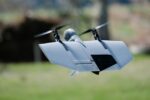New imagery of a previously unseen Chinese flying wing unmanned aerial vehicle (UAV) has surfaced online following its appearance at a domestic defense exhibition. The aircraft’s design suggests a focus on low observability and long-range missions—likely for intelligence, surveillance, reconnaissance (ISR), or precision strike roles. This development underscores China’s continued investment in advanced unmanned combat aerial vehicles (UCAVs), particularly those optimized for contested airspace operations.
Emerging Drone Revealed at Changchun Expo
The new drone was first publicly spotted during the Changchun Aviation Open Day 2025 event held in Jilin Province. Photos shared on Chinese social media platforms such as Weibo and reposted by defense watchers show a full-scale model or mock-up of a tailless flying wing UAV with characteristics similar to the GJ-11 “Sharp Sword” and the CH-7 stealth drones previously revealed by China.
The aircraft features a blended body-wing configuration with no vertical stabilizers—an architecture optimized for reduced radar cross-section (RCS). The engine exhaust appears to be shielded within the fuselage’s upper surface contours to minimize infrared signature and radar visibility from below. Notably absent are external sensors or underwing pylons—further suggesting an emphasis on stealth over multi-role flexibility.
Design Features Indicate LO Prioritization
The drone’s overall shaping aligns with established low-observable (LO) design principles used in Western platforms like the Northrop Grumman RQ-170 Sentinel or BAE Systems Taranis demonstrator. Key features include:
- Flying wing configuration: Eliminates vertical surfaces that reflect radar energy.
- Smooth surface treatment: Suggests radar-absorbent material coatings or composite construction.
- Buried engine inlet/exhaust: Likely reduces both radar and infrared signatures.
- No visible antennas or pitot tubes: Indicates flush-mounted sensors or internal systems to preserve RCS integrity.
This configuration likely sacrifices aerodynamic efficiency and payload flexibility in favor of survivability in high-threat environments—suggesting intended use against peer adversaries with integrated air defense systems (IADS).
Plausible Role as Strategic ISR or Strike Asset
While official specifications have not been released by Chinese authorities or state-owned aerospace firms like AVIC or CASC, analysts suggest that this new UAV could serve in either high-end ISR roles—similar to the U.S. RQ-170—or as a strike-capable UCAV akin to the GJ-11 Sharp Sword. The latter was first revealed during China’s 2019 National Day parade but remains shrouded in secrecy regarding operational status.
If equipped for strike missions, internal weapons bays would be essential to preserve LO characteristics while carrying precision-guided munitions such as satellite-guided bombs or air-to-surface missiles. Alternatively, if focused on ISR tasks, the platform may carry synthetic aperture radar (SAR), EO/IR sensors, electronic intelligence (ELINT) packages—or potentially even datalink relay payloads for contested communications environments.
A Growing Portfolio of Chinese Stealth Drones
This new platform adds to an expanding family of Chinese low-observable UAVs that includes:
- GJ-11 “Sharp Sword”: A subsonic flying wing UCAV developed by AVIC; believed to be undergoing testing with the PLA Navy Air Force.
- CASC CH-7: A larger HALE-class stealth drone unveiled at Zhuhai Airshow; reportedly designed for both ISR and precision strike missions.
- Anjian (“Dark Sword”): A conceptual supersonic UCAV possibly intended as an AI-enabled loyal wingman platform; status unclear.
The emergence of yet another stealthy UAV concept suggests parallel development efforts across multiple state-owned aerospace entities—possibly reflecting inter-service requirements from both PLA Air Force (PLAAF) and Navy (PLANAF).
Strategic Implications Amid Indo-Pacific Tensions
The timing of this reveal is notable given rising tensions across the Taiwan Strait and broader Indo-Pacific region. Stealth drones offer key advantages for long-range surveillance over maritime areas such as the South China Sea while minimizing risk of escalation due to their unmanned nature. In wartime scenarios, they could penetrate enemy IADS to conduct early battle damage assessment (BDA), electronic warfare support missions—or deliver kinetic strikes against high-value targets without risking manned assets.
The PLA’s increasing investment in LO drones also mirrors global trends among peer militaries seeking survivable unmanned systems capable of operating inside anti-access/area denial (A2/AD) bubbles. Whether this newly revealed system is already operational—or merely a technology demonstrator—is unclear. However, its public debut suggests confidence in its maturity level or strategic signaling intent toward regional rivals and observers alike.
Sourcing Ambiguities Remain
No official designation has been provided for this airframe as of September 2025. It remains uncertain whether it represents an evolution of existing programs like GJ-11 or CH-series drones—or an entirely new project under development by AVIC Shenyang Aircraft Corporation or another entity within China’s sprawling military-industrial complex. Satellite imagery analysis may eventually confirm test activity at known UAV development bases such as CAIG’s Anshun facility or AVIC’s Chengdu site.
Conclusion: Incremental Reveal Strategy Continues
This latest unveiling fits into China’s broader pattern of gradually disclosing advanced UAV capabilities through tightly controlled public displays rather than formal announcements. By showcasing mock-ups before confirming operational deployment status, Beijing maintains strategic ambiguity while signaling technological progress domestically and internationally.
If fielded successfully at scale—and integrated into joint C4ISR networks—the new flying wing drone could offer the PLA enhanced reach into contested domains across East Asia. Its emergence reinforces assessments that China is prioritizing survivable unmanned platforms as part of its evolving doctrine for informationized warfare under high-end threat conditions.









